Chemical Characterisation of Silanised Zirconia Nanoparticles and Their Effects on the Properties of PMMA-Zirconia Nanocomposites
Abstract
1. Introduction
2. Materials and Methods
2.1. Materials
2.2. Specimen Preparation
2.3. Materials Characterization
2.4. Mechanical Tests
2.5. Imaging of Particles and Fractured Surface
2.6. Statistical Analysis of Test Results
3. Results
3.1. Surface Morphology Analysis of Particles
3.2. Chemical Analysis of Particles
3.3. Analysis of Zirconia Functionalising by Silane
3.4. Flexural Strength and Modulus
3.5. Vickers Hardness
3.6. Fractured Surface Analysis
4. Discussion
5. Conclusions
Author Contributions
Funding
Institutional Review Board Statement
Informed Consent Statement
Data Availability Statement
Acknowledgments
Conflicts of Interest
References
- Da Silva, L.H.; Feitosa, S.A.; Valera, M.C.; De Araujo, M.A.; Tango, R.N. Effect of the addition of silanated silica on the mechanical properties of microwave heat-cured acrylic resin. Gerodontology 2012, 29, e1019–e1023. [Google Scholar] [CrossRef]
- Ayaz, E.A.; Durkan, R. Influence of acrylamide monomer addition to the acrylic denture-base resins on mechanical and physical properties. Int. J. Oral Sci. 2013, 5, 229–235. [Google Scholar] [CrossRef]
- Diaz-Arnold, A.M.; Vargas, M.A.; Shaull, K.L.; Laffoon, J.E.; Qian, F. Flexural and fatigue strengths of denture base resin. J. Prosthet. Dent. 2008, 100, 47–51. [Google Scholar] [CrossRef]
- Abdulwahhab, S.S. High-impact strength acrylic denture base material processed by autoclave. J. Prosthodont. Res. 2013, 57, 288–293. [Google Scholar] [CrossRef] [PubMed]
- Sasaki, H.; Hamanaka, I.; Takahashi, Y.; Kawaguchi, T. Effect of long-term water immersion or thermal shock on mechanical properties of high-impact acrylic denture base resins. Dent. Mater. J. 2016, 35, 204–209. [Google Scholar] [CrossRef]
- Zheng, J.; Wang, L.; Hu, Y.; Yao, K. Toughening effect of comonomer on acrylic denture base resin prepared via suspension copolymerization. J. Appl. Polym. Sci. 2012, 123, 2406–2413. [Google Scholar] [CrossRef]
- Machado, A.L.; Puckett, A.D.; Breeding, L.C.; Wady, A.F.; Vergani, C.E. Effect of thermocycling on the flexural and impact strength of urethane-based and high-impact denture base resins. J. Gerodont. 2012, 29, e318–e323. [Google Scholar] [CrossRef] [PubMed]
- Elshereksi, N.W.; Ghazali, M.J.; Muchtar, A.; Azhari, C.H. Studies on the effects of titanate and silane coupling agents on the performance of poly (methyl methacrylate)/barium titanate denture base nanocomposites. J. Dent. 2017, 56, 121–132. [Google Scholar] [CrossRef] [PubMed]
- Ergun, G.; Sahin, Z.; Ataol, A.S. The effects of adding various ratios of zirconium oxide nanoparticles to poly (methyl methacrylate) on physical and mechanical properties. J. Oral Sci. 2018, 60, 304–315. [Google Scholar] [CrossRef]
- Reyes-Acosta, M.; Torres-Huerta, A.M.; Dominguez-Crespo, M.A.; Flores-Vela, A.I.; Dorantes-Rosales, H.J.; Ramírez-Meneses, E. Influence of ZrO2 nanoparticles and thermal treatment on the properties of PMMA/ZrO2 hybrid coatings. J. Alloys Compounds 2015, 643, S150–S158. [Google Scholar] [CrossRef]
- Asar, N.V.; Albayrak, H.; Korkmaz, T.; Turkyilmaz, I. Influence of various metal oxides on mechanical and physical properties of heat-cured polymethyl methacrylate denture base resins. J. Adv. Prosthodont. 2013, 5, 241–247. [Google Scholar] [CrossRef]
- Alhareb, A.O.; Akil, H.M.; Ahmad, Z.A. Effect of nitrile butadiene rubber/Al2O3/YSZ fillers for PMMA denture base on the thermal and mechanical properties. J. Therm. Anal. Calorim. 2018, 134, 941–951. [Google Scholar] [CrossRef]
- Kundie, F.; Azhari, C.H.; Ahmad, Z.A. Effect of nano-and micro-alumina fillers on some properties of poly (methyl methacrylate) denture base composites. J. Serb. Chem. Soc. 2018, 83, 75–91. [Google Scholar] [CrossRef]
- Vojdani, M.; Bagheri, R.; Khaledi, A.A.R. Effects of aluminum oxide addition on the flexural strength, surface hardness, and roughness of heat-polymerized acrylic resin. J. Dent. Sci. 2012, 7, 238–244. [Google Scholar] [CrossRef]
- Zhang, X.Y.; Zhang, X.J.; Huang, Z.L.; Zhu, B.S.; Chen, R.R. Hybrid effects of zirconia nanoparticles with aluminum borate whiskers on mechanical properties of denture base resin PMMA. Dent. Mater. J. 2014, 33, 141–146. [Google Scholar] [CrossRef] [PubMed]
- Alhavaz, A.; Rezaei Dastjerdi, M.; Ghasemi, A.; Ghasemi, A.; Alizadeh Sahraei, A. Effect of untreated zirconium oxide nanofiller on the flexural strength and surface hardness of autopolymerized interim fixed restoration resins. J. Esthet. Restor. Dent. 2017, 29, 264–269. [Google Scholar] [CrossRef]
- Fan, F.; Xia, Z.; Li, Q.; Li, Z.; Chen, H. ZrO2/PMMA Nanocomposites: Preparation and Its Dispersion in Polymer Matrix. Chin. J. Chem. Engin. 2013, 21, 113–120. [Google Scholar] [CrossRef]
- Gad, M.M.; Rahoma, A.; Al-Thobity, A.M.; ArRejaie, A.S. Influence of incorporation of ZrO2 nanoparticles on the repair strength of polymethyl methacrylate denture bases. Int. J. Nanomedic. 2016, 11, 5633–5643. [Google Scholar] [CrossRef] [PubMed]
- De Souza Leão, R.; de Moraes, S.L.D.; de Luna Gomes, J.M.; Lemos, C.A.A.; da Silva Casado, B.G.; do Egito Vasconcelos, B.C.; Pellizzer, E.P. Influence of addition of zirconia on PMMA: A systematic review. Mater. Sci. Eng. C 2019, 106, 110292. [Google Scholar] [CrossRef]
- Mallakpour, S.; Dinari, M.; Neamani, S. A facile and green method for the production of novel and potentially biocompatible poly (amide-imide)/ZrO2–poly (vinyl alcohol) nanocomposites containing trimellitylimido-l-leucine linkages. Prog. Org. Coat. 2015, 86, 11–17. [Google Scholar] [CrossRef]
- Mallakpour, S.; Ezhieh, A.N. Polymer nanocomposites based on modified ZrO2 NPs and poly (vinyl alcohol)/poly (vinyl pyrrolidone) blend: Optical, morphological, and thermal properties. Polym. Plast. Technol. Eng. 2017, 56, 1136–1145. [Google Scholar] [CrossRef]
- Sabzi, M.; Mirabedini, S.; Zohuriaan-Mehr, J.; Atai, M. Surface modification of TiO2 nano-particles with silane coupling agent and investigation of its effect on the properties of pol-yurethane composite coating. Prog. Org. Coat. 2009, 65, 222–228. [Google Scholar] [CrossRef]
- Mohsen, N.; Craig, R. Effect of silanation of fillers on their dispersability by monomer systems. J. Oral Rehabil. 1995, 22, 183–189. [Google Scholar] [CrossRef]
- Lung, C.Y.K.; Sarfraz, Z.; Habib, A.; Khan, A.S.; Matinlinna, J.P. Effect of silanization of hydroxyapatite fillers on physical and mechanical properties of a bis-GMA based resin composite. J. Mech. Behav. Biomed. Mater. 2016, 54, 283–294. [Google Scholar] [CrossRef] [PubMed]
- Zhao, J.; Milanova, M.; Warmoeskerken, M.M.; Dutschk, V. Surface modification of TiO2 nanoparticles with silane coupling agents. Coll. Surf. A Physicochem. Eng. Asp. 2012, 413, 273–279. [Google Scholar] [CrossRef]
- Wang, X.; Song, X.; Lin, M.; Wang, H.; Zhao, Y.; Zhong, W.; Du, Q. Surface initiated graft polymerization from carbon-doped TiO2 nanoparticles under sunlight illumination. Polymer 2007, 48, 5834–5838. [Google Scholar] [CrossRef]
- Zidan, S.; Silikas, N.; Alhotan, A.; Haider, J.; Yates, J. Investigating the Mechanical Properties of ZrO2-Impregnated PMMA Nanocomposite for Denture-Based Applications. Materials 2019, 12, 1344. [Google Scholar] [CrossRef]
- Hu, Y.Q.; Zhou, S.X.; Wu, L.M. Surface mechanical properties of transparent poly(methyl methacrylate)/zirconia nanocomposites prepared by in situ bulk polymerization. Polymer 2009, 50, 3609–3616. [Google Scholar] [CrossRef]
- British Standards. British Standard Specification for Denture Base Polymers; BS 2487:1989 ISO 1567:1988; British Standards Institution (BSI): London, UK, 1989; p. 10. [Google Scholar]
- Sideridou, I.D.; Karabela, M.M. Effect of the amount of 3-methacyloxypropyltrimethoxysilane coupling agent on physical properties of dental resin nanocomposites. Dent. Mater. 2009, 25, 1315–1324. [Google Scholar] [CrossRef]
- Gad, M.M.; Abualsaud, R.; Rahoma, A.; Al-Thobity, A.M.; Al-Abidi, K.S.; Akhtar, S. Effect of zirconium oxide nanoparticles addition on the optical and tensile properties of polymethyl methacrylate denture base material. Int. J. Nanomedic. 2018, 13, 283–292. [Google Scholar] [CrossRef]
- Antonucci, J.M.; Dickens, S.H.; Fowler, B.O.; Xu, H.H.; McDonough, W.G. Chemistry of silanes: Interfaces in dental polymers and composites. J. Res. Natl. Inst. Stand. Technol. 2005, 110, 541–558. [Google Scholar] [CrossRef]
- Karabela, M.M.; Sideridou, I.D. Effect of the structure of silane coupling agent on sorption characteristics of solvents by dental resin-nanocomposites. Dent. Mater. 2008, 24, 1631–1639. [Google Scholar] [CrossRef]
- Tham, W.; Chow, W.; Ishak, Z.M. The effect of 3-(trimethoxysilyl) propyl methacrylate on the mechanical, thermal, and morphological properties of poly (methyl methacrylate)/hydroxyapatite composites. Appl. Polym. Sci. 2010, 118, 218–228. [Google Scholar] [CrossRef]
- Tham, W.; Chow, W.; Mohd Ishak, Z. Effects of titanate coupling agent on the mechanical, thermal, and morphological properties of poly (methyl methacrylate)/hydroxyapatite denture base composites. J. Compos. Mater. 2011, 45, 2335–2345. [Google Scholar] [CrossRef]
- Chow, W.; Tham, W.; Mohd Ishak, Z. Improvement of microstructure and properties of poly (methyl methacrylate)/hydroxyapatite composites treated with zirconate coupling agent. J. Thermoplast. Comp. Mater. 2012, 25, 165–180. [Google Scholar] [CrossRef]
- Alhotan, A.; Yates, J.; Zidan, S.; Haider, J.; Silikas, N. Flexural Strength and Hardness of Filler-Reinforced PMMA Targeted for Denture Base Application. Materials 2021, 14, 2659. [Google Scholar] [CrossRef] [PubMed]
- Pieniak, D.; Walczak, A.; Walczak, M.; Przystupa, K.; Niewczas, A.M. Hardness and wear resistance of dental biomedical nanomaterials in a humid environment with non-stationary temperatures. Materials 2020, 13, 1255. [Google Scholar] [CrossRef]
- Scribante, A.; Vallittu, P.; Lassila, L.V.; Viola, A.; Tessera, P.; Gandini, P.; Sfondrini, M.F. Effect of long-term brushing on deflection, maximum load, and wear of stainless steel wires and conventional and spot bonded fiber-reinforced composites. Int. J. Mol. Sci. 2019, 20, 6043. [Google Scholar] [CrossRef] [PubMed]
- Danaei, M.; Dehghankhold, M.; Ataei, S.; Hasanzadeh Davarani, F.; Javanmard, R.; Dokhani, A.; Khorasani, S.; Mozafari, M.R. Impact of particle size and polydispersity index on the clinical applications of lipidic nanocarrier systems. Pharmaceutics 2018, 10, 57. [Google Scholar] [CrossRef]

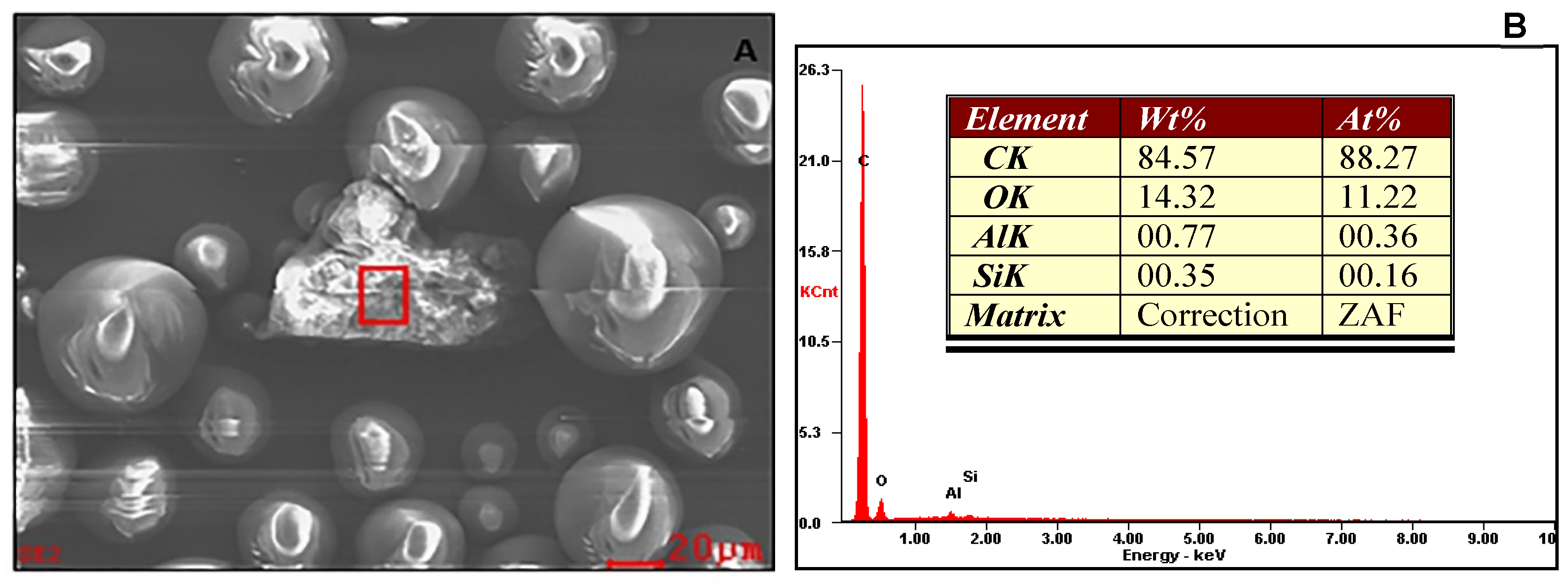

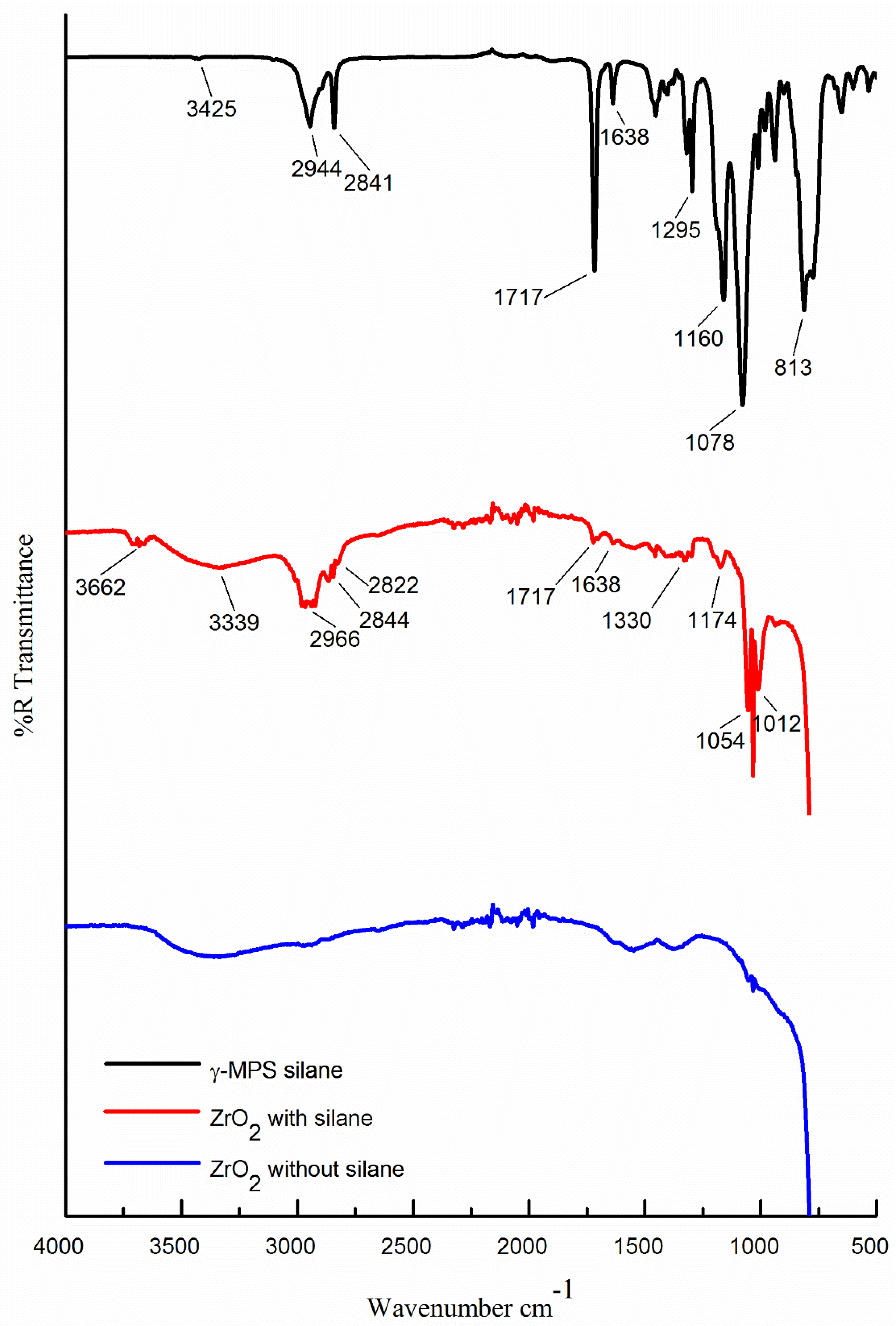
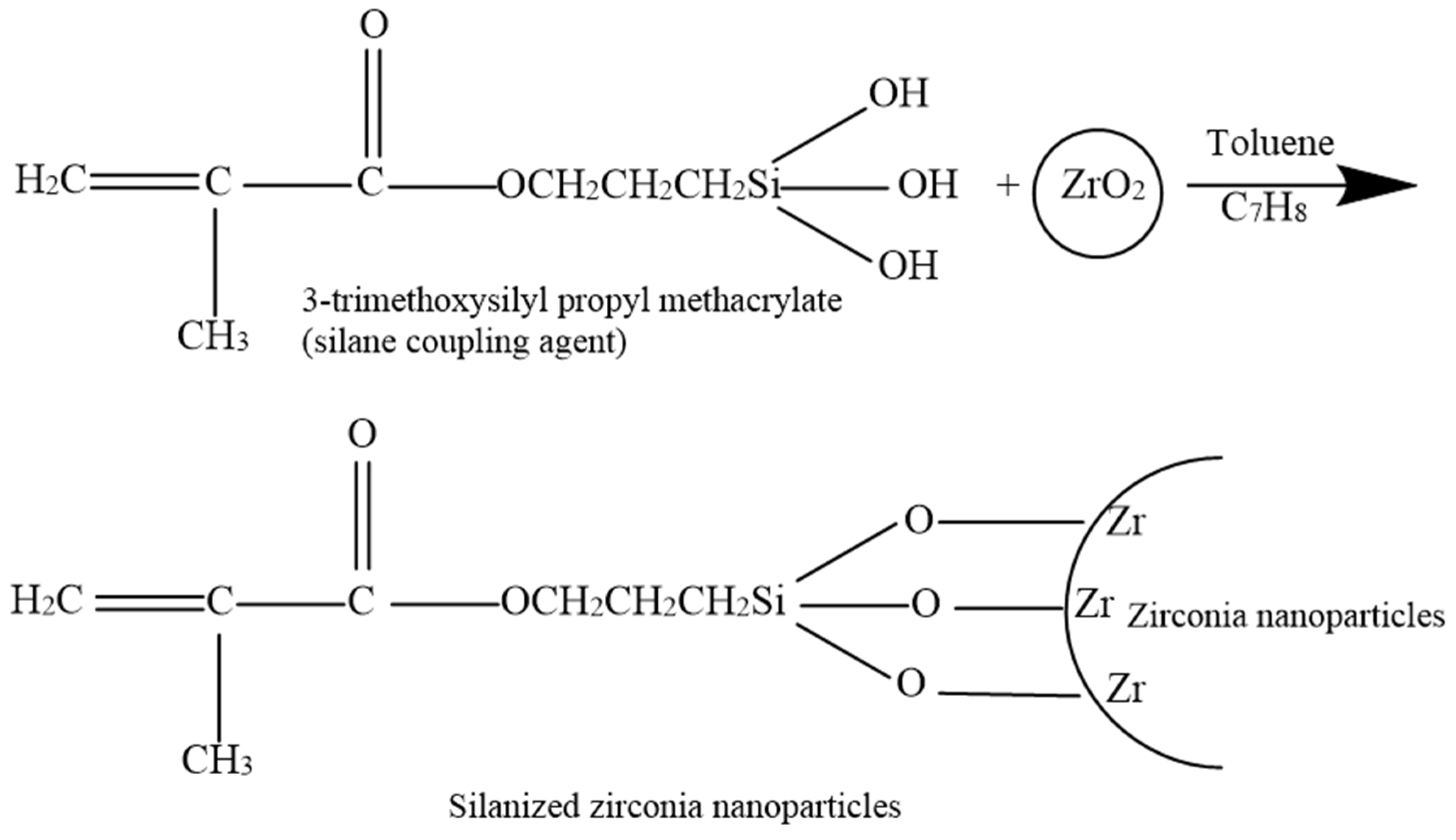
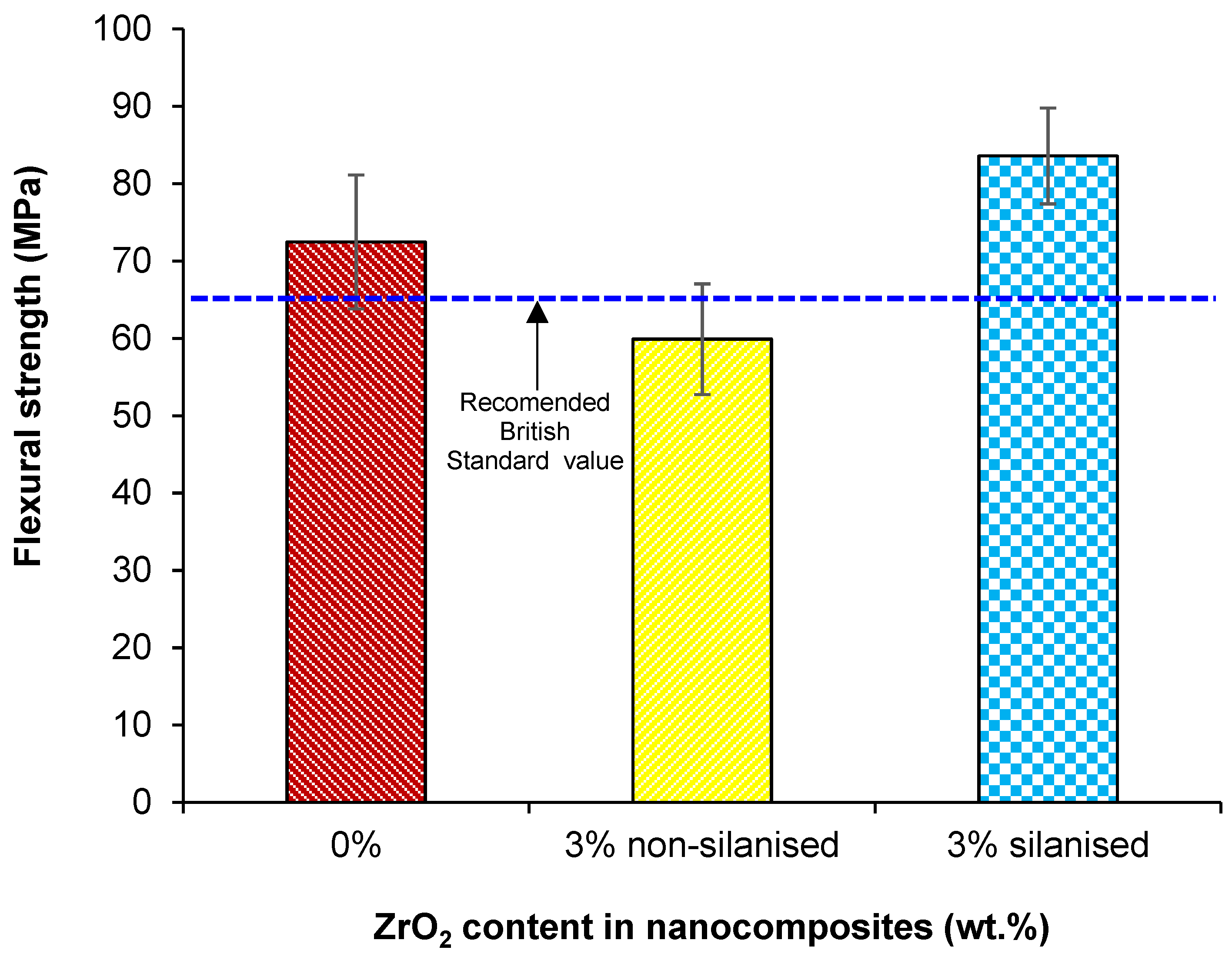
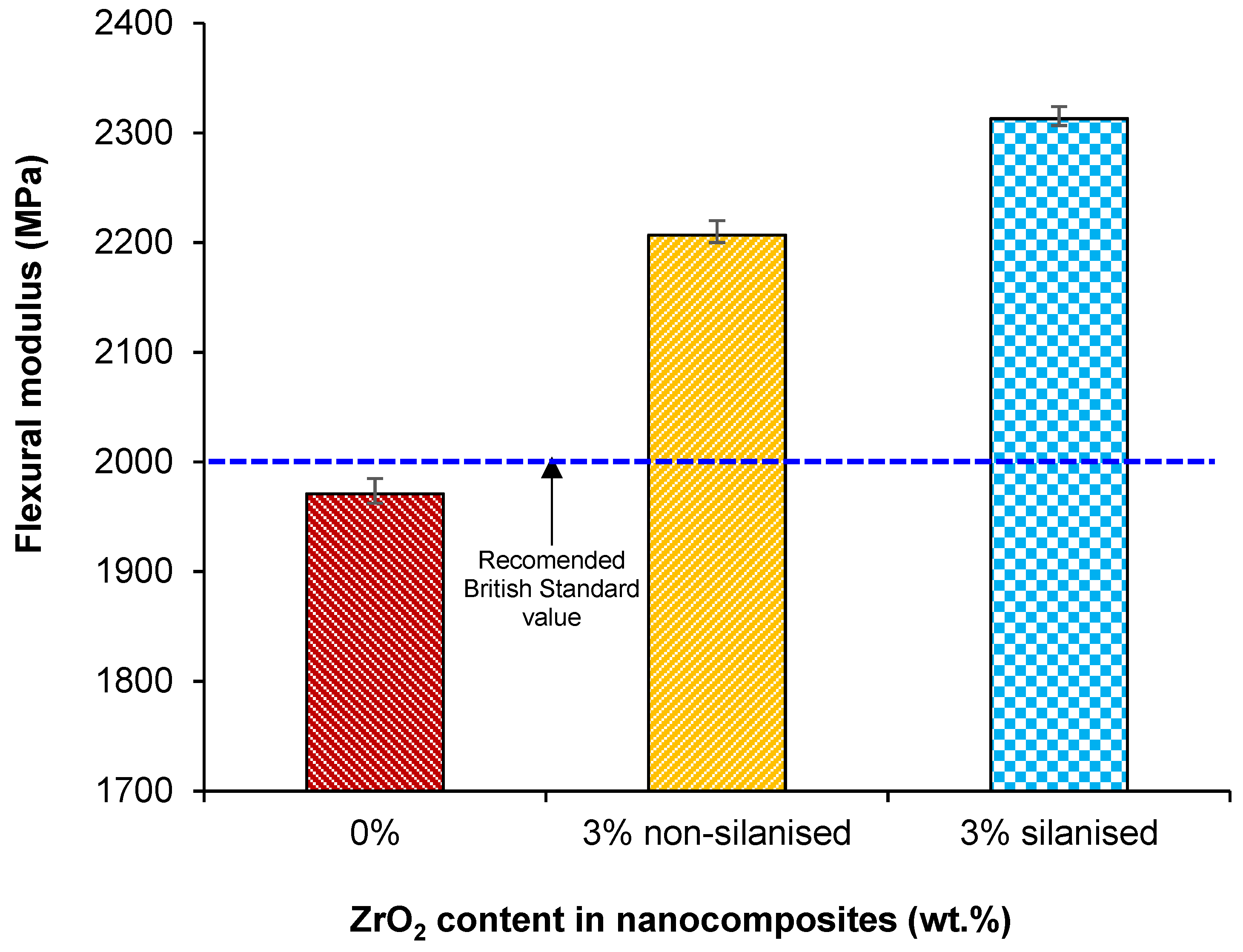

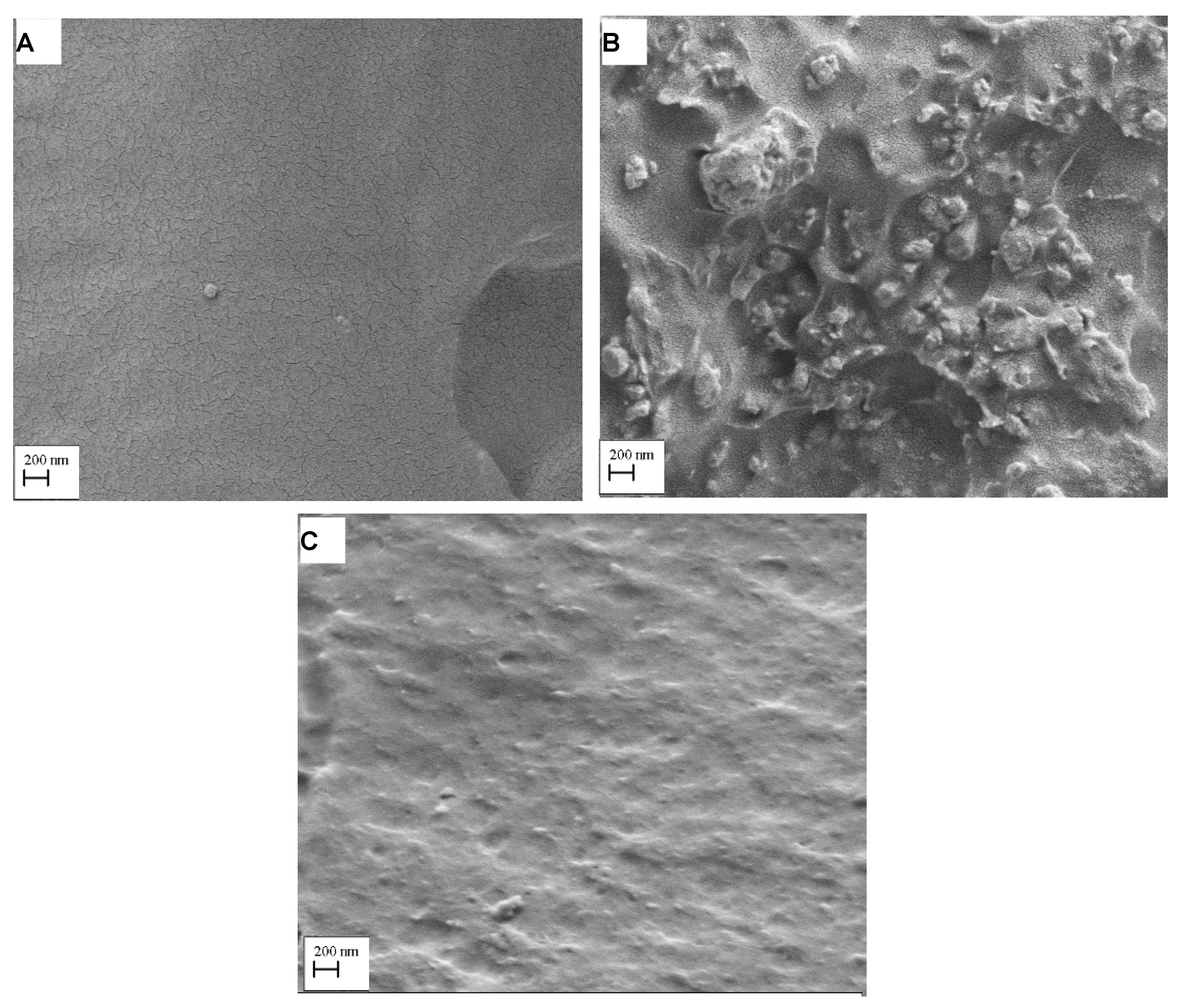
| Experimental Group | Zirconia (wt.%) | Zirconia (g) | HI PMMA Powder (g) | HI MMA Monomer (mL) |
|---|---|---|---|---|
| Control | 0.0 | 0.000 | 21.000 | 10.0 |
| 3.0 | 3.0 | 0.630 | 20.370 | 10.0 |
| Bond Type | Wavelength (cm−1) | Reference of γ-MPS |
|---|---|---|
| O-H | 3650–3200 | 3425 |
| CH3-CH2 | 2966–2844 | 2944–2841 |
| C=O | 1717 | 1717 |
| C=C | 1638 | 1638 |
| Zr-O | 1174–1054 | 1160–1078 |
| Zr-O-Si | 1330–1054 | 1160–1078 |
| Specimen Group | Flexural Strength (MPa) | Flexural Modulus (MPa) | Hardness (kg/mm2) |
|---|---|---|---|
| Mean & SD | Mean & SD | Mean & SD | |
| Control (0.0 wt.%) | 72.4 (8.6) A | 1971.0 (235.0) A | 17.1 (0.9) A |
| Non-silanised (3.0 wt.%) | 59.9 (7.1) B | 2207.0 (252.7) AB | 15.0 (0.2) A |
| Silanised (3.0 wt.%) | 83.5 (6.2) C | 2313.0 (161.3) B | 20.1 (2.3) B |
Publisher’s Note: MDPI stays neutral with regard to jurisdictional claims in published maps and institutional affiliations. |
© 2021 by the authors. Licensee MDPI, Basel, Switzerland. This article is an open access article distributed under the terms and conditions of the Creative Commons Attribution (CC BY) license (https://creativecommons.org/licenses/by/4.0/).
Share and Cite
Zidan, S.; Silikas, N.; Al-Nasrawi, S.; Haider, J.; Alshabib, A.; Alshame, A.; Yates, J. Chemical Characterisation of Silanised Zirconia Nanoparticles and Their Effects on the Properties of PMMA-Zirconia Nanocomposites. Materials 2021, 14, 3212. https://doi.org/10.3390/ma14123212
Zidan S, Silikas N, Al-Nasrawi S, Haider J, Alshabib A, Alshame A, Yates J. Chemical Characterisation of Silanised Zirconia Nanoparticles and Their Effects on the Properties of PMMA-Zirconia Nanocomposites. Materials. 2021; 14(12):3212. https://doi.org/10.3390/ma14123212
Chicago/Turabian StyleZidan, Saleh, Nikolaos Silikas, Suhad Al-Nasrawi, Julfikar Haider, Abdulrahman Alshabib, Alshame Alshame, and Julian Yates. 2021. "Chemical Characterisation of Silanised Zirconia Nanoparticles and Their Effects on the Properties of PMMA-Zirconia Nanocomposites" Materials 14, no. 12: 3212. https://doi.org/10.3390/ma14123212
APA StyleZidan, S., Silikas, N., Al-Nasrawi, S., Haider, J., Alshabib, A., Alshame, A., & Yates, J. (2021). Chemical Characterisation of Silanised Zirconia Nanoparticles and Their Effects on the Properties of PMMA-Zirconia Nanocomposites. Materials, 14(12), 3212. https://doi.org/10.3390/ma14123212








